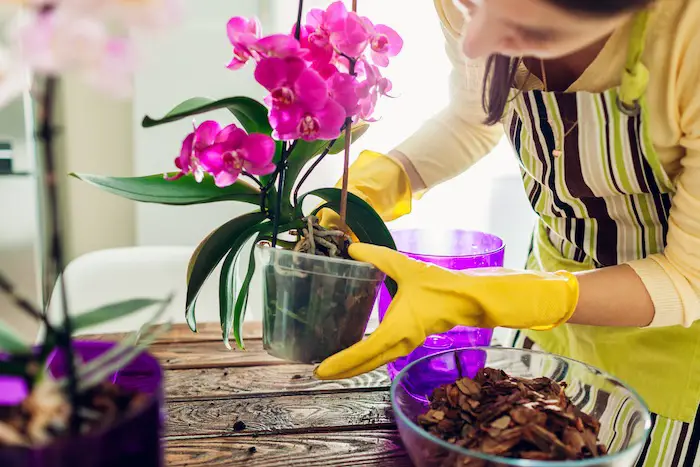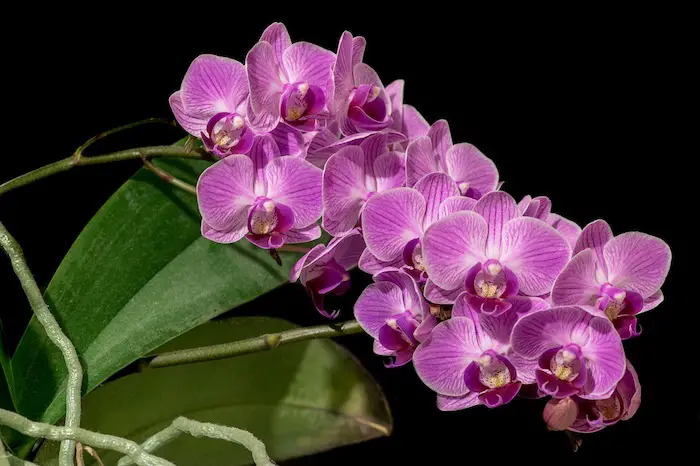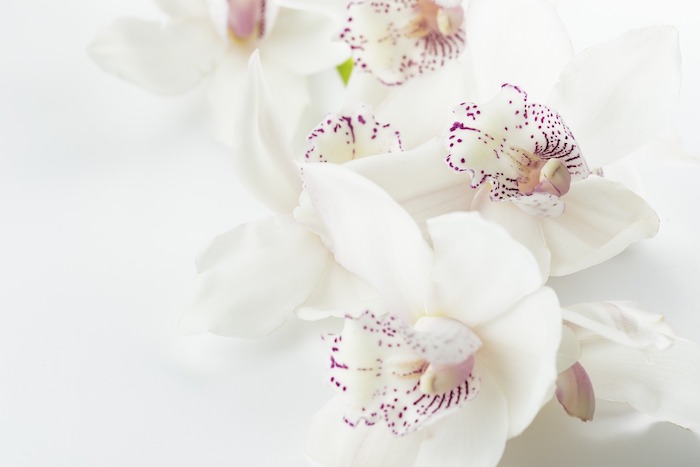Orchids can make for a beautiful, brightly colored addition to any home. But it is important to know not only the proper techniques for watering your orchids but what materials to use as well to ensure that they grow properly.
There are many different ways to properly water orchids so that they grow to be bright and beautiful. But the process does take some fine-tuning and experimentation so don’t be shocked if it takes you a few times before you get it right.
Potting Materials
One of the most important factors when it comes to proper orchid care and growth is making certain that the right potting materials are optimal. Selecting the right potting materials can have a major impact on the growth rate of your orchids but it can be easy to pick the wrong type.
The properties and functions of the most ideal potting materials are various. Potting materials supply nutrients and water to your orchids. They also maintain an adequate level of aeration around the root system.
Proper potting material will also allow for good root anchorage as well as the proper amount of room that is needed for root development (people often plant their orchids too close together and they don’t have enough room to properly grow).
The best potting materials will also be free of toxins and absorb water quickly. This allows for adequate drainage as well as the proper absorption and release of nutrients. Most of all, the proper potting material will not decompose too quickly, giving it the time that it needs to properly take effect on the roots.
Generally speaking, there is no single potting material that can meet all of those requirements. Thankfully, there are two additions that can be made to your standard potting material that can aid in the growth process.
The two most common are bark and sphagnum moss, which we will simply refer to as moss. Both have their own distinct benefits and disadvantages, making either a quality option that offers assistance to make the growing process total.
Bark provides good aeration for your root system. Not only that, it helps produce larger cavities for the roots to grow in, giving your orchids the proper amount of space to grow adequately. The downside is that bark is not good at storing water, meaning that your orchids won’t get the proper amount of water without a little bit of help.
Moss, meanwhile, makes for a very good substrate. It has great water retention abilities, which makes it excellent when planting young orchids. If you could find a way to provide proper aeration so that the roots would have proper respiration, moss would be a great addition.
But let’s say that you went with moss as your potting material addition. How would you water your orchids in the moss? What other ways are there to water your orchids? There are a few helpful ways to keep your orchids nice and hydrated while giving the roots the proper amount of space to grow.
Watering Orchids in Moss
One of the keys to watering your orchids is to ensure that you do not overwater them. Again, moss makes for a very good container for water, holding it to allow for proper hydration as the orchids continue to grow.
But since moss holds so much water, that can make it a bit easier to overwater your orchids. This is why finding other techniques are essential. But how can you prevent overwatering of your orchids without giving the moss time to dry out?
Water an Orchid with Ice Cubes
Using ice cubes is a great way to water your orchids without overwatering them. But the caveat here is that you are not using nearly as much water so underwatering is possible as well. And while ice cubes may pack a perfect amount of water, there is also the cold factor to consider. Orchids are not terribly fond of the cold as they are tropical plants so you also have to be careful to not put too much ice in the orchid pot.
So if you want to use the ice cube method for watering your orchids, all that you need to do is place two or three at most in the orchid potting medium. If you can, keep the ice away from the crown, leaves, and orchid roots in order to prevent damage to those portions of the plant.
Setting the ice cubes on the crown in particular can be a death sentence for the orchids. It cannot be overstated how carefully you must place your ice cubes if you are to use this method of watering your orchids. It provides for a safe amount of water but can be dangerous if placed carelessly.
Without Using Ice Cubes
If using ice cubes is not quite what you wanted to implement, you can use methods that exclude them. Since moss is quite absorbent, there is a chance that you could accidentally keep the inner core of the moss constantly wet. This results in rotted roots, which will ultimately kill the orchids.
This is why the ice cube method is so popular despite the possible negative impacts of the cold. Think about it this way: three ice cubes is about only two tablespoons of water or so, preventing overwatering of the orchids.
So, if you want to prevent overwatering without the risks that come with using ice cubes, the answer is simple. All you need to do is water your orchids in the potted moss by adding just a few tablespoons of water to the potting medium.
There is another trick if you are growing Phalaenopsis orchids in particular. You can use a style known as kokedama. This is the method of wrapping the roots in a ball of soil and then wrapping that ball in moss. This winds up looking like a ball of moss with an orchid sticking out.
Using this method means that you can soak the kokedama in water without having to worry about oversaturation or root rot. The way to water this is to wait until the ball feels almost hard and then set it in a bowl of water. All it takes is a few minutes for the moss to absorb the water and that’s all there is to it.
You can also have a look at this video:
If You Use Bark
If you do decide to opt for bark instead of moss for your potting material, it is well known that bark does not do so well when it comes to water retention. This means that you need different techniques in order to provide the adequate amount of water needed to keep your orchids growing and healthy.
Bark makes for a popular choice for potting medium because it has great draining properties. Orchids don’t do well when they sit in water and bark is a great way to prevent that from happening. The bark doesn’t retain water as moss does, making it difficult to overwater when using bark.

There are two accepted ways of watering your orchids in a pot that has bark as its basic potting medium. Those two methods are watering from above and below. Whichever way you choose to do it, the key is to make certain that you water in copious amounts to offset the bark’s inability to retain water.

Also of note: if you live in a dry climate, you might want to add a few cubes of wool rock to your potting mix. Since the bark does not retain water very well, you will want to increase the water retention of your potting mixture.
Most important of all is proper drainage in your orchid potting mix. Your orchids need good drainage so that they don’t stay wet in the middle. This can essentially drown your orchids, killing your plants before they ever get started. Try using a tall, narrow pot when planting your orchids. Doing this will allow the center of the pot to dry quickly, preventing the middle from soaking.
Watering Your Orchids From Below
This method of watering your orchids is so that you do not have to constantly water from above. All you need to do is set your orchid in a water-filled pot. By using this method, you allow your orchid roots to soak up the water that they need. Even better, this keeps the crown from becoming rotted by keeping it dry.
Keep in mind that you need to prevent disease when watering from below. Do this by using the same pot with the same orchid every time that you water. Don’t mix pots or switch them either. There are actually certain types of orchids that benefit from being watered by below.
That is because certain types of orchids are prone to what is known as leaf spotting. Keeping the leaves of your orchid dry helps to prevent any bacterial growth on the leaves themselves. And it is that bacterial growth that results in spotted leaves.
Watering Your Orchids From Above
Should you decide to go with the method of watering your orchids from above, you can actually water them right in the faucet. The good thing about this is that it is easy to control the strength of the stream and some faucets allow you to control the force of the flow as well.
If you do water your orchids in the kitchen sink, be sure to use a drain catch in order to prevent any wood chips from getting down into your drain. And as always, keep the water-sensitive crown of the orchid from over-soaking as well.
There is a benefit to watering your orchids from above. This is because it makes for a great way to flush the orchid potting medium of any fertilizer salts. Even if you aren’t using the kitchen faucet as your main source of water, it is a good idea to do so anyway in order to wash out those salts. Try doing this every month or so.
Should watering from above become too messy, try using a watering can like this. This way, you are able to provide proper moisture without soaking the crown.
Know When to Water Your Orchids
There are a few ways that you can determine when it is time to water your orchids. When you do water, make certain that you do it in the morning; this gives the crown time to dry off during the day and actually helps prevent crown rot.
One method of checking is to use your finger. Stick your finger into the growing medium and see if it feels as if it is almost dry. If it is, it is time to water. If you don’t want to put your finger in, try something such as a toothpick and leave it in for five minutes, then take it out to see if it is wet.
Another great way to check the moisture level of your orchid is to look at the drainage hole. By doing this, you can see if your planting medium is dry. Should you have a secondary pot inside the main pot, lift it out of the secondary pot so that you can inspect the planting medium.
There are also those with the right amount of experience who can simply lift the pot and determine if it needs water. If your pot feels light, there’s a good chance that your potting medium requires a watering.
Growing orchids can make for a great addition to any home. They are beautiful, vibrant-looking flowers but they do require some tweaking in order to grow them properly. Too much or too little water can be enough to kill your orchid, requiring you to start over.
Giving your orchids a better chance at growing successfully means using bark or moss to help in the growth process. It may seem a little uncertain in the beginning but eventually you will have the experience needed to know when to water your orchids or to abstain and hold off a little longer.
See Also:
Ultimate List Of Fragrant Orchids
How Long Do Orchids Live In A Pot
Are Orchids Poisonous (Human&Pets)
Can You Eat Orchids


